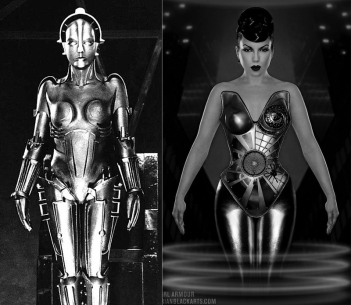Most of us are familiar with the highly developed and sophisticated set of terms used to describe the female body. (Understanding that gender is a complex creature, here by female body I mean the traditional concept of the biological female body.) Many, if not most, of these terms compare women to animals. In my experience some women don’t care, some women find them empowering, and many find them demeaning. This is totally understandable. I guess it just depends on the individual.
I am quite certain most of these terms are available on Urban Dictionary in case you are unsure of their meaning, but here I have provided a few of the most famous ones. Unsurprisingly, the majority of them seem to treat women in terms of their sexual relation to men. A simple Google search for each term reveals its image in the popular imagination. Oh, I suppose this is the time to tell you that the below images are not safe for work. Also, *trigger warning* for potentially degrading images.
First, we have the bitch:
OK, so this term does not refer strictly to the body, but it still compares women to animals, which is a running theme here. The bitch is supposed to be an unpleasantly feisty woman. Funny. I would never call Helena Bonham Carter a bitch—I would just call her magnificently talented—but I guess you could make the argument that a bitch is a good thing.
Then there is the fox:
While the bitch is a ball-breaking ‘cock-blocker’ (not exactly the same thing as a cuckold), the fox is a pornographic delight for heterosexual men everywhere. Samantha Fox, who happens to have a female partner (to the chagrin of men who grew up in the ’80s), calls her fans ‘foxies’, so sometimes it might be a positive term.
The fox closely resembles the vixen (which happens to be a female fox):
Here I have used a picture of the character Vixen from the Disney film The Fox and the Hound because a Google search of vixen yielded nothing but images of ’80s hair bands and pornography models. The vixen, I think, is supposed to be more sweetly seductive than the fox.
Even more seductive is the sex-kitten:
Obviously, the term does refer to her sexual relation to a man (or, I suppose, her sexual relation to a woman too.) The sex kitten puts the vixen to shame. She is ultra-cute and coy, and loves to toy with men’s desires. Personally, my idea of a sex kitten is Michelle Pfeiffer as Catwoman—a lady who will claw your balls off if you fuck with her:
In this case I must maintain that the sex kitten resembles something more akin to a powerful, self-asserting agent—like the Egyptian goddess Bastet—than a pleasantly-purring princess. Of course, this was from a film in which men themselves were compared with bats and penguins. Oh, there was also the Poodle Woman, but she was more creepy than sexy, which I kind of like.
And what of the majestic cougar?
She is the sexually mature, over-forty mother of cats. There are many a pimpled teenage boy who fantasize about her. But why can’t older women be sexual and vibrant without kow-towing to silly puerile sex fantasies? Jessica Lange, Miranda Richardson, and Ellen Burstyn have already proved it is possible.
But the complimentary anthropomorphic archetypes end there, it seems, for we also have the dog:
Does this look like a woman to you? It doesn’t to me. I am pretty confident in saying this is categorically cruel and demeaning.
Another case in which the woman is compared negatively with an animal is the cow:
I guess this is supposed to refer to an overweight woman? So, what? It’s cruel and unnecessary. I take great delight in the thought of a cow daintily trampling the smug teenage boys (and sometimes older men) who mock women’s weight.
The nail in the coffin is the whale:
The whale is actually a graceful and intelligent creature, but somehow this fact has escaped the minds of those who compare women’s bodyweight to that of a whale. Hopefully they get crushed by a calving cow while surfing the waves of southern California and, while pinned under her weight, have to watch her calf suckle from her teat, as the cow and her calf wash away. That would be sweet justice.
This trend in ascribing animal traits to women applies to lesbians too, particularly in the form of the bull-dyke:
This is just one image of the bull-dyke, and it suggests there is power in the term. There are other images which are decidedly less sympathetic. The bull-dyke is a large, strong, assertive gay woman. I guess this is another case of ‘pick or choose’ whether you like the term or not. By the way, is that Betty Friedan? At any rate, I think she rocks.
Another lesbian category is the lipstick lesbian:
In accord with the third-wave feminist movement, she needn’t be masculine in order to be a woman. I don’t see a problem with that. Women should be able to be whatever they want to be, whether masculine, feminine, or gender-queer. Again, I guess it’s your business whether or not you like the term ‘lipstick lesbian’.
Let us not forget the leatherdyke:
She wears leather and rides around on a motorcycle. She takes the dominant, butch role in sexual relations with other women, her preferred instrument of pleasure being either a fist or the strap-on dildo. Her leather gear symbolizes her tough exterior, which is supposed to be attractive to lipstick lesbians.
There is a very interesting intersection between women and gay men in terms of nomenclature: both groups have been categorised by body type, especially in terms of animals or sexual nature. The dynamic might be different with gay men in that there isn’t a heterosexual male presence influencing the categorisation, but there is an internal, sometimes self-defeating, pressure to do so. And sometimes women do view men in objectifying ways, although I think it’s safe to say this is less common only because women know by experience what it feels like to have this done to them.
Some straight women will feel guilty about making some of these categorisations—and yet I almost want them to, because it would suggest that they acknowledge that they have sexual desires too. This doesn’t feel harmful to me, since I know men have traditionally been perceived as the sexual agents, and women, as the sexual patients. So read on, straight women and gay men.
Perhaps the most popular man is the twink:
He is called a twink because he is smooth and filled with cream, like a Twinkie. (Gay men are vile and disgusting in their metaphor.) He is the property of Hostess, which is now owned by the private equity firms Apollo Global Management and Metropoulos & Co. Forget animals. He is a processed piece of junk-food from the local convenience store. How’s that for dehumanization?
But then there is the bear:
Bears adopt a rough and gruff exterior, but are often surprisingly sensitive and articulate. They do co-habitate, but the bear-net is loose. Some bears tend toward chubs or otters. (We will get to these latter two below.) Sadly, some of them believe in the ‘straight-acting’ script, which states that a real man isn’t gay, because gay men are somehow unmanly (whatever ‘manly’ is supposed to be). Bears who like leather are called ‘leather bears’.
A young, small bear is called a cub. A cub is just a baby bear; he is younger. What he has in common with his older peer, though, is that he tends to be hirsute. Hair is the crowning glory of the cub and the bear, whether it be a beard, or—ahem—anything else.
Akin to the cub and bear is the otter.
The otter is basically the same thing as the cub or bear—he is hairy—but unlike the cub or bear the otter is always slighter in build. Also he tends to have a markedly playful nature.
Similar to bears, cubs, and otters is the satyr:
The satyr is half otter, half ‘average’. That is, while he has an average amount of hair on the upper half of his body, he has an enormous amount of the stuff on the lower half. Admittedly, it is not the most common of body terms used in the gay community, but it exists. The satyr of Greek mythology has an enormous sexual appetite, but I am unsure how far this applies in the modern-day gay male usage of the term.
And then there is the chub. The chub is just a large man, like the female whale:
Some people like the term chubs, some people don’t. Some people are attracted to chubs and seem to use it in a complimentary way, yet I can’t help but think that the term is flippant, if not slightly degrading. Again, decide for yourself.
Then there is the dolphin:
Like the twink, the dolphin is slim and hairless (and usually white), but unlike the twink he usually shaves it off so he can swim faster through the water. I guess he would be like a slim, sexy whale (depending on your preferences, of course). And like satyr, the term dolphin isn’t very common, but it exists. He is the prototypical gay bar go-go dancer.
One of the stranger creatures is the leatherdaddy:
The leatherdaddy is much like the leatherdyke—he performs an assertive, dominant sexual role—and he is usually older than his twinkish partner. I don’t get the weird ‘daddy’ thing—it kind of creeps me out—but I think it’s just supposed to signify adoration of an older, powerful man. Also like the leatherdyke, the leatherdaddy is totally into BD/SM. Oh, and Tom of Finland’s caricature of the male form is obviously exaggerated (as caricatures are)—most men do not have such ridiculously broad shoulders and narrow hips. I guess it’s just a fantasy.
Finally, there is the pig:
By pig, I don’t mean ‘male chauvinist pig’, I just mean a hungry, nasty sex animal. That is the way it is used in the gay male community. The pig doesn’t necessarily dislike romance—he may love it—but he is noted for his love of rough, loud sex. He is into all sorts of things that I cannot possibly enumerate here, nor should I for the sake of decency.
So there you have it. Those are the chief terms used to describe the bodies of women and gay men. Sometimes the term does not refer specifically to the body, but it does refer to the personality and the way in which the individual relates to another, often sexually. I won’t even attempt here to dissect how the media influences concepts of physical beauty—that is an entirely separate blog entry—but I do want to draw your attention to the way people categorise women and gay men according to body and personality type. Some people like it, some don’t, and some just don’t care. My only caveat is this—never be mean-spirited.






















































